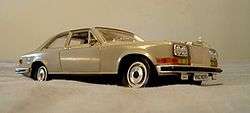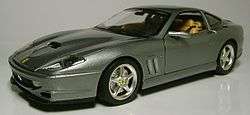Bburago
 | |
| Industry | Diecast Model Cars |
|---|---|
| Founded | 1976 |
| Headquarters | Burago di Molgora, Italy |
Key people | Mario, Ugo, and Martino Besana, Founders |
Number of employees | 130 |
| Parent | May Cheong Group |
| Website |
www |
BBurago is an Italian model car manufacturer, that was based in Burago di Molgora, Italy, which made mostly diecast cars from 1976 to 2005. At its most popular, Bburago's main competition were Politoys and Maisto the latter of which was to become dominant in the 1:18 market segment around 2000. Showing Maisto's influence in this market, since 2007 Bburago has been a brand under that group.
Nomenclature
Called Martoys from 1974 to 1976, the company was founded by Mario, Ugo, and Martino Besana, who had previously started Mebetoys, which they sold to Mattel (Force 1992, 124). While Mebetoys had been 1:43 scale, Martoys, however, focused on larger toys in 1:24 and 1:18 scales. Martoys was renamed BBurago in 1976. BBurago (with two "B's") is the correct spelling, ostensibly standing for both the town name as well as the name of the Besana family. It is an easy detail to miss - even a book presented by the revered auction house Christie's misspells the name (Richardson 1999, p. 173).
Early models
One of the earliest BBurago lines were a series of 1:43 scale Fiat trucks, but these seem to have disappeared by about 1980, according to Force (1992, pp. 22, 124-125). Continuing the Martoys line-up, however, most models were produced initially in 1/24 scale and mostly represented contemporary European sports and saloon cars. Most were well-detailed and included many opening features. Later, a range of 1/18 vehicles were produced which was to become the "bread and butter" of BBurago offerings. In the mid-1980s a new 1/43 scale line was begun. As they were held together by screws, models in 1/24 and 1/18 were also commonly issued in kit form (later, 1/43 kits appeared as well).

While vehicles in the kit ranges used the same castings as their contemporaries in the fully assembled ranges, the kits often depicted different versions, usually in racing or rally style. BBurago kits were notorious for featuring waterslide transfers which never adhered properly to the models, making well-built examples of the kits rare. Clearcoat could be sprayed over the unassembled model to "seal-in" the decals. Conversely, the transfers on factory built cars were of the 'stick-on' variety, rather than the 'tampo' printing used by the likes of Maisto.
Larger scales
Originally, the 1/18 scale range was aimed more at collectors, and BBurago was the link between European niche marketing in 1/43 scale and the 1/18 scale surge that occurred during the 1990s. BBurago was the first manufacturer to make this scale the main offering of the company, after Schuco, Gama, and Polistil pioneered larger offerings, but who by the late 1970s were going out of business. BBurago was also a contemporary of the mail order offerings of Franklin Mint Precision Models which were pricier, but sometimes of spotty quality.

BBurago did not, however, stick strictly to 1/18, with smaller cars like the Renault Alpine A1pine A110 and the FIAT 500 presented in 1/16 and larger vehicles like the Ford F-150 pickup in 1/21. 1/24 was also a regular size. The Ford pickup, however, is an exception as European marques were a main focus of the Italian company. At first, offerings consisted mostly of 1930s cars, but later more 1950s and 1960s models were introduced, like the Jaguar XK-E roadster. Finally, many contemporary high performance automobiles, like the Lamborghini Diablo, appeared and some of these were the company's most popular sellers.
For cost savings, models were often duplicated from one scale to another. The "Diamond", "Super", and "Gold" ranges were the main lines in 1/18 scale with over 30 different models. Each vehicle would be offered in two or three colors and often in a roadster and coupe version (BBurago 1996). Differences in the ranges are hard to discern, but the Super line was more aligned to classic cars, while the "Gold" series had more deluxe packaging.
There were also several lines in 1/24 scale. These included the Grand Prix, Bijoux, VIP, and Super lines. The Super series included many normal coupes, sedans, and micro-cars in rally and police liveries, with 45 different models (BBurago 1996). The Grand Prix line consisted of ten Formula One and Indy Cars.

The larger models usually had all apertures opening, had detailed engines, spare tires in trunks, working steering, windshield wipers and detailed instrument panels. A number of models also feature active suspension and removable wheels. Early on was there was a use of plastics for door and bonnet openings. These parts sometimes hindered fit and finish, and, after extended play, would stretch or bend, causing hoods and doors to not close properly.
BBurago's 1/43 scale "Pocket" series consisted of about 36 offerings in about 60 separate liveries. These had simple 'Hot Wheels' inspired chrome on hard plastic tires, and no opening features, but were good value for the money (Rixon 2005, p. 76). Though oriented more to children in price (often selling for only a couple of dollars), 1/43 model detail was excellent and the presentation - like the early SAAB 900 or the long-lived MCA Montecarlo Centennaire model (one version with Russian MIG sponsorship) - was quite attractive (BBurago 2000).
Competition increases
By the late 1990s, the company no longer had the 1/18 collector market to itself as competitors both high and low end such as Exoto, Maisto, Yatming, Ertl, Mira, Revell, Jouef, Anson, and also Mattel were producing models, some of which were of higher quality and precision. Maisto became the main diecast brand in larger scales and began to eclipse most other manufacturers.
Many of these companies had an edge as their products could be produced with far cheaper labor in Thailand and China, while BBurago continued production in Italy. By 2005, the receivers were called in and BBurago was finally purchased by Maisto. This essentially marked the end of Italian manufactured (and European manufactured) affordable mass production diecast vehicles.
Prior to its closure, the company was also hard-hit by an exclusive promotional contract granted to Mattel for the production of model Ferraris. As much money had been invested in the tooling to produce these models, the company was adversely affected. This contract has now changed and other diecast manufacturers (including BBurago) are again making miniatures of the prancing horse, but at the time this limited the offerings of BBurago (and others).
Death and rebirth
BBurago cars, especially the early 1/24 scale models, are now collectible, and it is thought that the final models issued under the old management will also become similarly prized. Of the early cars, the rarest models are generally considered to be the Lancia Beta sedan introduced under the Martoys name, and the Innocenti Mini 120. The Lamborghini Cheetah 4x4, Renault 4L, Fiat 124 Spyder Abarth, Alfetta GTV and BMW 3.0 CSL "Batmobile" are all also now rare and valuable.
Other collectible BBuragos include some rare promo models, like examples of the Camargue finished in metallic gold-green, and at least one model that was issued only in mainland Europe; the Lancia Ypsilon in 1/24. The final 1/18 car issued before bankruptcy was the Peugeot 907 concept car.
At the time the company ceased production of all its Ferrari models, a model of the Ferrari 360 Spider in 1/18 scale was about to be introduced. It is thought that a few may have left the factory (although this is not confirmed).

As of early 2007, the name has been relaunched. It is now owned by the May Cheong Group which markets Maisto, so the situation is analogous to Mattel owning both Hot Wheels and Matchbox. In order for both lines to be successful they must be differentiated in some manner. May Cheong's answer is to make BBurago's offerings more European. A count from the two brands' websites in 2011 confirms the two approaches. Out of 64 1/18 scale cars, BBurago only has 6 models that are not European - or 9 percent. Maisto, with 113 total 1/18 scale models, on the other hand, has 53 non-European models or 47 percent non-European. May Cheong bets it can avoid internal competition among brands by having Maisto carry a more global selection of vehicles. Many of the earlier BBurago models made at the time of the May Cheong takeover are now being produced again in Thailand and China, along with new castings. By 2011, some models, like the smaller scale "Race and Play" series of "garage" scene Ferraris, were again appearing in retail stores like Toys-R-Us. It appears that no models are made in Italy any longer.
References
- BBurago '96. 1996. Annual catalog. Printed in Italy. 80 pages.
- BBurago 2000. Annual catalog. Printed in Italy. 98 pages.
- Force, Dr. Edward. 1992. Classic Miniature Vehicles Made in Italy. West Chester, Pennsylvania: Schiffer Publishing. ISBN 0-88740-433-2
- Richardson, Mike and Sue. 1999. Christie's Presents The Magical World of Automotive Toys. San Francisco: Chronicle Books. ISBN 0-8118-2320-2
- Rixon, Peter. 2005. Miller's Collecting Diecast Vehicles. London: Miller's a Division of Mitchell Beasley.
External links
- Official website
- History of BBurago and other model car manufacturers
- BBurago Diecast
- BBurago model reviews at Diecast Zone